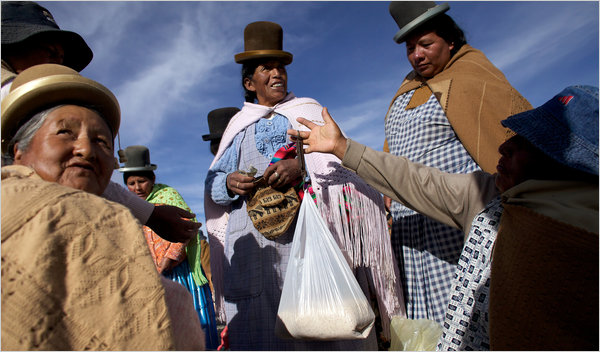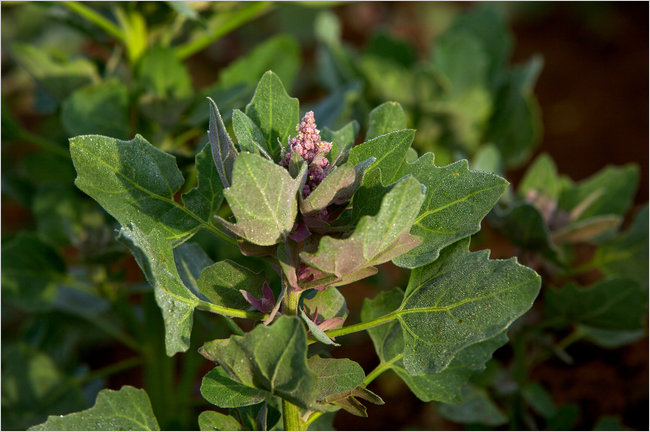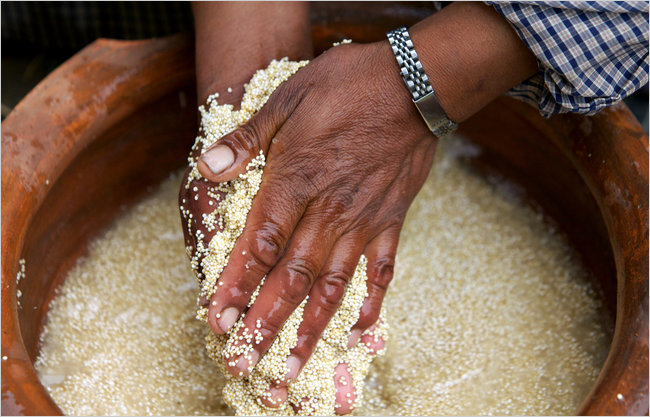
(above) Women weighing a bag of quinoa in a local market in Batallas, Bolivia. (photo:Noah Friedman-Rudovsky for The New York Times)
Quinoa's Global Success Creates Quandary at Home
March 10, 2011 - NY Times
By SIMON ROMERO and SARA SHAHRIARI
LA PAZ, Bolivia -- When NASA scientists were searching decades ago for an ideal food for long-term human space missions, they came across an Andean plant called quinoa. With an exceptional balance of amino acids, quinoa, they declared, is virtually unrivaled in the plant or animal kingdom for its life-sustaining nutrients.
But while Bolivians have lived off it for centuries, quinoa remained little more than a curiosity outside the Andes for years, found in health food shops and studied by researchers -- until recently.
Now demand for quinoa (pronounced KEE-no-ah) is soaring in rich countries, as American and European consumers discover the "lost crop" of the Incas. The surge has helped raise farmers' incomes here in one of the hemisphere's poorest countries. But there has been a notable trade-off: Fewer Bolivians can now afford it, hastening their embrace of cheaper, processed foods and raising fears of malnutrition in a country that has long struggled with it.
The shift offers a glimpse into the consequences of rising global food prices and changing eating habits in both prosperous and developing nations. While quinoa prices have almost tripled over the past five years, Bolivia's consumption of the staple fell 34 percent over the same period, according to the country's agricultural ministry.
The resulting quandary -- local farmers earn more, but fewer Bolivians reap quinoa's nutritional rewards -- has nutritionists and public officials grasping for solutions.
"As it's exported, quinoa is now very expensive," said María Julia Cabrerizo, a nutritionist at the Hospital de Clínicas, a public hospital here. "It's not a food of mass consumption, like noodles or rice."
Quinoa, domesticated thousands of years ago on Bolivia's arid high mountain plains and now often misrepresented as a grain, is actually a chenopod, related to species like beets and spinach. Its seeds have a light, nutty taste, and when cooked become almost translucent.
(below) A quinoa plant flowering three months before it will be harvested. (Photo: Noah Friedman-Rudovsky for The New York Times)

While the Incas relied on quinoa to feed their soldiers, it was only recently that Bolivian farmers, with the help of European and American foreign aid organizations, started growing quinoa for export.
The focus on foreign markets has altered life in isolated places like Salinas de Garcí Mendoza, a community on the edge of the salt flats in southern Bolivia where much of the country's quinoa is produced. Agricultural leaders claim that rising exports of the plant have lifted living standards there and in other quinoa-growing areas.
"Before quinoa was at the price it is now, people went to Argentina and Chile to work," said Miguel Choque Llanos, commercial director of the National Association of Quinoa Producers. Now, he said, rising quinoa prices have also encouraged city dwellers to return to their plots in the countryside during planting and harvest seasons.
Yet there are causes for concern. While malnutrition on a national level has fallen over the past few years thanks to aggressive social welfare programs, Ms. Cabrerizo, the nutritionist, said studies showed that chronic malnutrition in children had climbed in quinoa-growing areas, including Salinas de Garcí Mendoza, in recent years.
In Salinas de Garcí Mendoza and elsewhere, part of this change is due to climbing quinoa prices and more quinoa being destined for export.
"I adore quinoa, but I can't afford it anymore," said Micaela Huanca, 50, a street vendor in El Alto, a city of slums above the capital, La Paz. "I look at it in the markets and walk away."
Officials in President Evo Morales's government say that changing food preferences and increased ability to buy processed foods also play a role.
"It has to do with food culture, because if you give the kids toasted quinoa flour, they don't want it; they want white bread," said Víctor Hugo Vásquez, vice minister of rural development and agriculture. "If you give them boiled water, sugar and quinoa flour mixed into a drink, they prefer Coca-Cola."
The shift away from consuming quinoa in the cradle of its cultivation has alarmed some of the plant's top marketers in the United States, where quinoa is increasingly coveted by health-conscious consumers.
"It's kind of discouraging to see stuff like this happen, but that's part of life and economics," said David Schnorr, the president of the Quinoa Corporation of Los Angeles, one of the largest importers of quinoa in the United States, which has worked with Bolivian producers since the 1980s.
Mr. Schnorr said quinoa's climbing prices in the United States were raising other concerns as well. "At $5 a box, only so many people can afford that," he said, adding that he would prefer a price about half that amount. "I've always been an advocate of expanding the market, keeping the prices to a point where more people can try it."
Here in Bolivia, government officials are trying to increase domestic quinoa consumption, even as the product faces steep competition from other foods. At supermarkets here, a 1,000-gram bag of quinoa, just over two pounds, costs the equivalent of $4.85, compared with $1.20 for a bag of noodles the same weight and $1 for a bag of white rice.
(below) Quinoa being prepared: it must be rolled, sorted and washed numerous times. (photo: Noah Friedman-Rudovsky for The New York Times)

President Morales said this month that he planned to make more than $10 million in loans available to organic quinoa producers, and health officials are incorporating the plant into a packet of foods supplied to thousands of pregnant and nursing women each month.
Mr. Vásquez, the rural development official, said quinoa would also be available in meals for the armed forces and in more school breakfasts. "That's already under way in some municipalities," he said, "but we want to expand."
Some here cling to eating quinoa despite its rising price. Paulina Vásquez, 52, a housekeeper and mother of three children in their 20s who live with her in a poor district on a steep mountainside of La Paz, sows the crop each year on her family's land outside the city. The packaged quinoa found in supermarkets is beyond what her family can afford.
Instead, they harvest their own, store it and then prepare it by hand, a painstaking process that includes washing away the resinlike saponin coating that protects the seeds. Ms. Vásquez regularly prepares a sweet drink of quinoa, apple, cinnamon and sugar for her family for breakfast.
But she says many in the younger generation have moved away from it. "People my age and older are eating quinoa," Ms. Vásquez said. "The young people don't want it. If there is a pot of noodles everyone is there, as if noodles were nutritious. Even my children are that way."